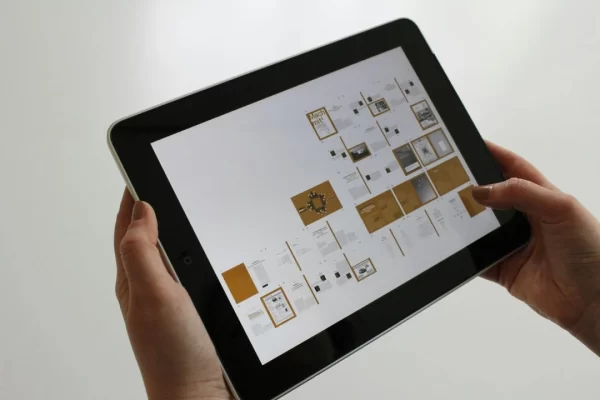The website footer is often an overlooked component in web design, yet it holds significant potential to enhance user experience and drive conversions. A well-designed footer can provide crucial information, reinforce brand credibility, and guide users towards desired actions, ultimately improving conversion rates. In this blog post, we’ll explore how to design a website footer for better user experience and conversions, examine the essential elements of a high-converting footer, delve into the design principles that make it effective, and discuss common mistakes to avoid.
By the end, you’ll have a comprehensive understanding of how to design a website footer that not only looks great but also performs effectively.
Key Takeaways
- A thoughtfully designed website footer enhances user experience, strengthens brand credibility, and drives higher conversion rates.
- Essential footer elements include navigation links, contact information, social media icons, trust signals, and clear calls-to-action (CTAs).
- Following footer design best practices—like keeping it simple, ensuring readability, making it mobile-friendly, and maintaining consistent styling—is critical for success.
- A strategic footer supports SEO by improving internal linking, boosting site structure clarity, and encouraging user engagement.
- Avoid common mistakes such as overloading the footer, neglecting design consistency, and failing to optimize for mobile users to maximise your footer’s impact.
Table of Contents
- Key Takeaways
- What is a Website Footer?
- Importance of a Footer in Web Design
- Key Elements of a High-Converting Footer
- Design Principles for an Effective Footer
- Common Mistakes to Avoid When Designing Your Website Footer
- Elevate Your Website with Digital Rescue
- FAQs
What is a Website Footer?
A website footer is the section at the bottom of a webpage. Understanding the basics is crucial before learning what should be included in a high-converting website footer. It typically contains essential information that users might need but isn’t necessary to include in the main content. This can include contact details, navigation links, social media icons, and legal information such as privacy policies and terms of service. The footer serves as a catch-all space for additional information that supports the overall functionality and user experience of the website.
Essential Elements of a Website Footer
A well-designed footer typically includes:
- Navigation Links – Quick access to key pages, improving site navigation.
- Contact Information – Business address, email, and phone number for easy communication.
- Social Media Links – Direct connections to platforms like Facebook, Instagram, and LinkedIn.
- Legal Information – Privacy policies, terms of service, and disclaimers to ensure compliance.
- Call-to-Action (CTA) – Newsletter sign-ups, special offers, or important updates.
These elements are considered best practices for creating a high-converting website footer, helping to guide users seamlessly across your site.
Best Practices for Designing an Effective Footer
Following website footer best practices for conversions ensures your site not only looks professional but also supports your marketing goals.
To create a functional and visually appealing footer, follow these best practices:
- Keep it Simple & Organized – Avoid clutter by grouping related elements.
- Use Readable Fonts & Colors – Ensure text is easy to read against the background.
- Make it Mobile-Friendly – Optimize for responsiveness across all devices.
- Include a Clear CTA – Encourage actions like signing up for a newsletter or exploring services.
- Ensure Accessibility – Use proper contrast, font size, and descriptive links for all users.
By implementing these best practices, you can enhance both usability and engagement while maintaining a professional website appearance.
Importance of a Footer in Web Design
Often overlooked, the footer is a vital part of a well-structured website. Despite being at the bottom, it significantly impacts user experience, navigation, and overall site effectiveness. Here’s a deep dive into why a well-designed footer is essential in web design.
Enhancing User Navigation
The primary role of a footer is to enhance navigation. It provides easy access to additional information and important links, keeping visitors from needing to scroll back to the top. This can include:
- Quick Links: Providing links to key pages like About Us, Contact, Services, and FAQ helps users find what they need quickly.
- Sitemap: A comprehensive sitemap in the footer allows users to see an overview of the website’s structure, making it easier to navigate.
- Secondary Navigation: Links to lesser-promoted but essential pages can be conveniently placed in the footer.
Quick access links and sitemaps are just two examples of how a footer can improve your website’s conversion rate.
Establishing Brand Credibility
A footer can greatly enhance a website’s credibility by including elements that build trust and assure visitors of its reliability and professionalism. Key elements that contribute to this include:
- Contact Information: Providing detailed contact information (address, phone number, email) makes a business appear more legitimate and accessible.
- Certifications and Awards: Displaying industry certifications, awards, and memberships can build trust with visitors.
- Privacy Policy and Terms of Service: Including links to these legal documents shows that the business is transparent and trustworthy.
Supporting Conversion Goals
Footers can drive conversions by including targeted call-to-action (CTA) elements, guiding users to take desired actions even after they scroll through the main content. Effective CTAs in footers might include:
- Newsletter Sign-Ups: Encouraging visitors to subscribe to a newsletter can help build a mailing list for future marketing efforts.
- Contact Forms: Links or small forms for getting in touch directly from the footer can increase lead generation.
- Special Offers: Promoting special deals or discounts in the footer can capture the interest of users who have explored the entire page.
Providing Legal Information
The footer is the ideal location for important legal information that users need to know but doesn’t fit into the main body of the webpage. This includes:
- Privacy Policy: Informing users about how their data is collected, used, and protected.
- Terms of Service: Outlining the rules and regulations for using the website.
- Cookie Policy: Explaining the use of cookies on the site and obtaining user consent where necessary.
Strengthening SEO
A well-structured footer with keyword-rich internal links highlights what makes a website footer effective for user engagement and SEO. Key SEO elements in the footer might include:
- Anchor Text Links: Using keyword-rich anchor text in footer links can help improve the site’s relevance for those keywords.
- Internal Links: Linking to important pages within the site helps search engines crawl and index the site more effectively.
- Consistent Structure: A well-structured footer can help search engines better understand the site’s organisation.
Enhancing User Engagement with Social Media
Including social media icons in the footer encourages visitors to connect with the brand on various platforms, enhancing engagement and brand loyalty. Best practices include:
- Consistent Branding: Social media icons should match the website’s overall design.
- Prominent Placement: Icons should be easily visible but not overwhelming.
- New Tabs: Links should open in new tabs to keep users on the website while they check out social media pages.
The footer is crucial in web design, serving multiple functions like enhancing navigation, establishing credibility, supporting conversions, and providing legal info. Thoughtful design and inclusion of these elements can significantly improve user experience and help businesses achieve their website goals effectively.
Key Elements of a High-Converting Footer
In web design, the footer often remains an underutilised asset. However, when crafted with intention, it can be a powerful tool for boosting conversions and enhancing user experience. Here are the key elements that contribute to a high-converting footer:
Contact Information
- The contact information segment of a website’s footer is vital for establishing trust and accessibility. It typically includes a clickable phone number, an email address with a direct link, a physical address, particularly crucial for local businesses, and a link to a contact form for easy inquiries.
Navigation Links
- Incorporating secondary navigation links in the footer helps users find essential pages without needing to scroll back to the top of the page. These links often include sections like About Us, Services/Products, Blog, and FAQs, offering visitors easy access to relevant information.
Social Media Icons
- The footer is an ideal location for social media icons, encouraging visitors to connect with the brand across various platforms. To optimise engagement, ensure the icons maintain consistent branding, are prominently placed for visibility, and open links in new tabs to prevent users from navigating away from the site entirely.
Call-to-Action (CTA) Buttons
- Strategically positioned CTAs in the footer prompt users to take specific actions, even after they’ve scrolled through the main content. Examples of effective CTAs include subscribing to a newsletter, requesting a quote, or signing up/logging in for personalised experiences.
Trust Signals
- Trust signals play a crucial role in the footer, contributing to establishing credibility and reassuring visitors about the safety and reliability of the website. These signals may include security badges, industry-related certifications, customer testimonials, and links to privacy policies and terms of service.
Incorporating these key elements into your website’s footer can significantly enhance user experience, boost conversions, and foster trust with visitors, ultimately contributing to the success of your online presence.
Design Principles for an Effective Footer
Let’s explore essential design principles for creating a powerful footer. By focusing on visual hierarchy, consistency, responsiveness, and readability, you can enhance your website’s user experience, navigation, and conversion rates.
Visual Hierarchy
- Visual hierarchy is important for highlighting the footer’s most essential elements. Designers achieve this by using different font sizes, weights, and colours to direct users’ attention to vital information. This ensures that contact details, navigation links, and CTAs are easily noticeable and accessible, enhancing the footer’s overall usability.
Consistency
- Consistency in footer design is crucial for a smooth user experience. Fonts, colours, and styling should match the website’s overall look. This not only makes the footer visually appealing but also strengthens brand identity. Users should move seamlessly from the main content to the footer without noticing any design inconsistencies.
Responsiveness
- In today’s mobile-focused world, making sure the footer works well on all devices is crucial. Designers need to adjust the layout and features of the footer to fit different screen sizes. Elements should be easy to tap and use on small screens, ensuring a seamless experience for mobile users. A responsive footer improves user experience and ensures all important information is accessible on any device.
Readability
- Readability is crucial for an effective footer. Designers should focus on legibility by selecting suitable font sizes, styles, and spacing. The text should be easy to read against the background to avoid eye strain. Also, avoid overcrowding the footer with too much text or clutter. Instead, opt for clear and organised content to improve understanding. Prioritising readability ensures users can easily access the information they need from the footer.
Common Mistakes to Avoid When Designing Your Website Footer
When designing a website footer, certain pitfalls can hinder its effectiveness and impact on user experience. Here are five common mistakes to avoid:
Overloading with Information
- A common mistake is overcrowding the footer with too much information. While it’s tempting to include every link and detail, this can overwhelm users and diminish the effectiveness of essential elements. Keep the footer clean and concise by including only the most critical information and links that support user navigation and conversion goals.
Neglecting Design and Readability
- A badly designed footer with hard-to-read text, conflicting colours, or inconsistent styling can harm the website’s overall look and erode user trust. Align the footer design with the rest of the site, using suitable fonts, colours, and spacing for easy reading. Maintain consistency and prioritise visual hierarchy to highlight essential elements and ensure a seamless user experience throughout the footer.
Inconsistent Styling
- Using different fonts, colours, or layouts in the footer compared to the rest of the website can disrupt the user experience. Keep a consistent design by aligning the footer with the site’s overall look, ensuring it blends seamlessly with the main content. Consistent styling reinforces brand identity and professionalism, building user trust and engagement.
Lack of Call-to-Action (CTA)
- Not having clear and compelling calls-to-action (CTAs) in the footer misses the chance to prompt users to take desired actions. Whether it’s subscribing to a newsletter, requesting a quote, or exploring related content, footer CTAs can boost user engagement and conversions. Integrate strategic CTAs aligned with your website goals to give users a clear next step. Missing these CTAs means missing opportunities to leverage tips for designing a footer that improves website performance.
Ignoring Mobile Users
- Ignoring mobile optimisation for the footer is a big mistake as more people browse on mobile devices. Make sure the footer is responsive and easy to use on smaller screens, with links and buttons that are easy to tap. Mobile users should have the same smooth experience as desktop users, accessing essential information and features in the footer.
By avoiding these common mistakes and implementing best practices in footer design, you can create a more effective and user-friendly website footer that enhances navigation, reinforces brand credibility, and drives conversions.
Elevate Your Website with Digital Rescue
Remember, a well-designed footer serves as a valuable asset, providing users with essential information, guiding navigation, and reinforcing brand credibility. By implementing best practices and heeding the advice outlined in this article, you can maximise the potential of your website footer to achieve your business goals.
For businesses in Melbourne seeking expert web design solutions, look no further than Digital Rescue. As Melbourne’s trusted web design agency, we specialise in crafting visually stunning, user-friendly websites that drive results. Our experienced designers and developers are dedicated to understanding your unique needs and delivering tailored solutions that exceed expectations.
Whether you’re looking to redesign your website footer, overhaul your entire site, or embark on a new digital project, Digital Rescue’s team of experienced designers and developers is here to help. Contact us today to learn how we can transform your website into a powerful tool for driving business growth and success.
FAQs
Why is the website footer important for user experience and conversions?
The footer enhances navigation, provides critical contact and legal information, and encourages actions like newsletter signups—all contributing to a better user experience and improved conversion rates.
What key elements should every website footer include?
Essential elements include navigation links, contact details, social media icons, trust signals (like certifications), legal links (privacy policy, terms of service), and a clear call-to-action (CTA).
How does a footer help with SEO?
A footer improves SEO by offering keyword-rich internal links, strengthening site architecture, and ensuring search engines can effectively crawl and index important pages.
What are the best practices for designing an effective website footer?
Keep it clean and organized, maintain consistent design with the main site, ensure mobile responsiveness, use clear CTAs, and prioritise readability with suitable fonts and colours.
What are common mistakes to avoid in footer design?
Common mistakes include overcrowding the footer with too much information, inconsistent design, ignoring mobile users, and failing to include actionable CTAs that drive user engagement.
Should social media links be included in the footer?
Yes, including social media links in the footer boosts user engagement and brand visibility. They should open in new tabs and match the website’s design style for a seamless experience.
How can a footer build brand credibility?
A footer builds credibility by displaying detailed contact information, certifications, customer testimonials, and essential legal information, all of which reassure visitors of your trustworthiness.



